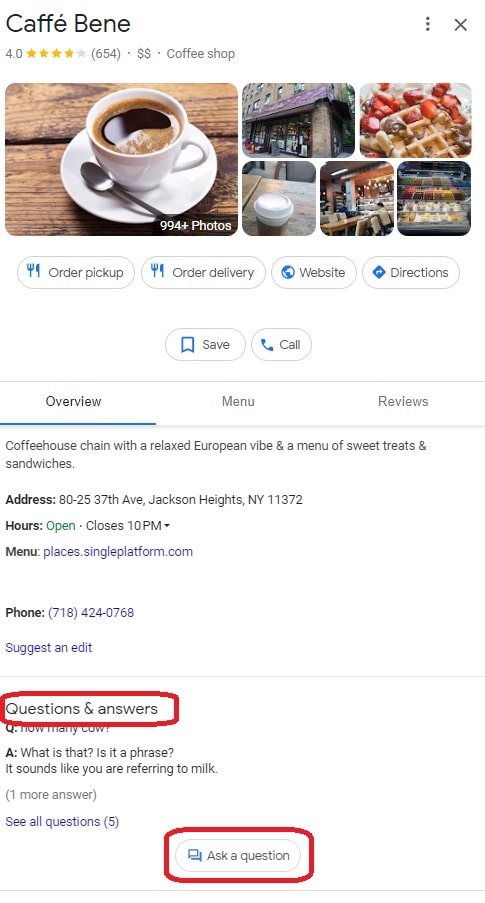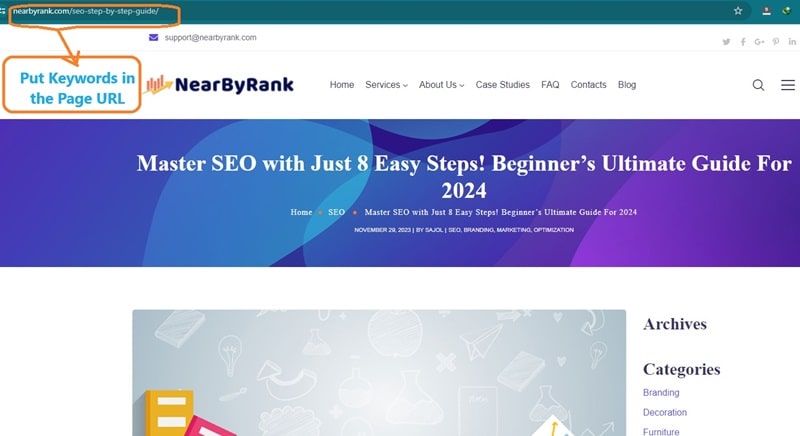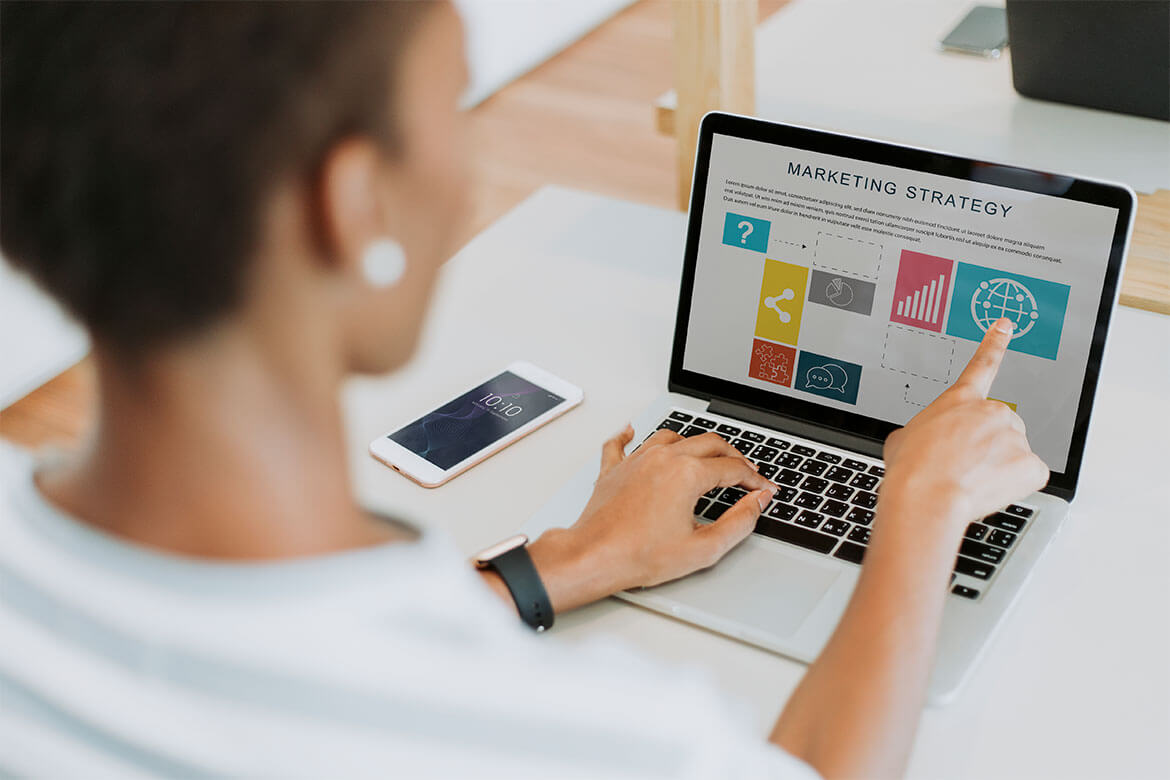7 Ways To Improve Local SEO & Attract New Business
There is a big difference between the way standard organic SEO works and the way we should approach Local SEO.
Not only is searcher intent likely different, but the algorithms Google uses to show the map pack differs from the main organic algorithms.
In this article, I’ll be taking you through the ways you can win new customers and improve your visibility through local SEO.
Check Competitors' Google Business Q&As
Google Business Profile (GBP) has a great function that can do wonders for growing new business – the questions and answers feature.
If you use it well for your organization, it can help convert customers who are otherwise on the fence.
But don’t stop there. Spend time researching your competitors’ Q&As, too. See what your potential customers are asking others in your industry.
How GBP Q&A Works
On your Google Business Profile, you may notice an “Ask a Question” button. Once clicked, users are taken through to a screen that allows them to submit a question.

Screenshot from Google Business Profile, December 2023
This next part is crucial. The question is not submitted to the owner of the profile; instead, it is submitted to the profile itself. This means it is visible to anyone who views a Google Business Profile listing.
Once a question has been posted on your competitors’ Google Business Profile listing, you will be able to see it.
And once the question is answered, that information – along with the engagement – is there for everyone to see in the future.


How Does This Help Build New Business?
These questions are a great way to encourage new business from local searchers. Questions are likely to be asked by people who have never visited that business before but are in your target market.
They are already engaging with the brand but need a bit more information before they commit to a visit.
For Your Own Listing
On your own GBP, you can use this opportunity to converse with a potential local consumer who is far down the conversion funnel.
If they are at the stage where they have found you and are considering you enough to ask some questions, a thoughtful response may be all it takes to see them walk through your doors.
On A Competitor’s Listing
Look at what questions your competitors’ customers and potential customers are asking. Use this to better fill out the information on your own profile and website.
If you are noticing a lot of questions being asked about the availability of gluten-free pizza from other pizza restaurants in your area, for example, you want to make sure you highlight your gluten-free products on your site and listing.
This type of research can keep you one step ahead of local competitors, especially if the questions they have been asked are slightly negative in tone.
Consider this question: “Do you still play loud music?”
If a potential restaurant-goer sees that question asked of another business, it immediately makes them consider the environment they will be eating their meal in.
It may make them wonder if they will really be able to enjoy the catch-up with their friends over a meal as they have planned.
Answer the questions being asked of your competitors on your own website and GBP before anyone asks. State in your description that customers will enjoy a meal accompanied by relaxing, ambient music.
This can put you at a significant advantage over your competitors for winning new business in your geography.
When you proactively answer a potential customer’s question before they even have to ask it, you demonstrate that you understand their needs and wants.
2. Tweak A Google Product Listing To Get More Exposure
Google allows businesses with GBP to upload details of the products they offer. This can be viewed by potential customers on both mobile and desktop search results.
The listings appear in the GBP in a carousel format on Maps and both a carousel and under the Products tab in Search.
Both formats allow users to click on the product cards for more details, to call, or to visit the website.
How GBP Product Listings Work
Uploading your products to a Google Business Profile has gotten simpler. Google has released a new way of doing this called “Pointy.” Pointy is a device that is plugged in between the barcode scanner and the point-of-sale device. As products are scanned in, Pointy adds them to Google.
This is a quick way of uploading your product inventory to your Google Business Profile. There are restrictions around this, however, as Pointy is only available in some countries and also isn’t suitable for products without barcodes (bunches of flowers, for instance).
It is still possible to upload products manually. Simply sign in to your profile and click Edit Profile > Products > Add Product.
How Does This Help Build New Business?
You may be looking to showcase some products over others for a variety of reasons. You may have a surplus of stock in one of your locations, for example.
Bringing that stock to the forefront of that location’s GBP listing will help alert local customers to it. It will allow you to target specific products more to relevant audiences, depending on their location.
For instance, seasonal products may be better served first. Perhaps the geographic location of your car repair shop is set for an unseasonal snow flurry. Edit your snow tire listings to bring them to the beginning of the carousel.
This could enhance the visibility of your product at just the right time for a new customer in your target location to see them.
3. Use Google’s Business Messages While You Can
Google Business Profile can include functionality that allows businesses to correspond with customers straight from the SERPs.
When activated, GBP will display a Message button that users can click on to start direct messaging with the business.
How GBP Business Messages Work
This functionality has existed since 2017 in Google Business Profile and since 2018 in Google Maps. It has only recently made it onto the desktop, however.
If you are an owner of a GBP, you should see the option in your desktop dashboard to Turn on messaging under the Messages tab.
You can then set items like an initial auto-responder to be sent out when a visitor first messages you are using this service.
To make sure the service is a timely one, Google recommends you reply to all messages within 24 hours.
If you don’t, Google may deactivate the messaging service on your account. Your response times can also show in Google Search and Maps.
Google may display ‘Usually responds in a few minutes,’ ‘Usually responds in a few hours,’ ‘Usually responds in a day,’ or ‘Usually responds in a few days,’ depending on your average reply time.
How Does This Help Build New Business?
Not everyone has the time (or inclination) to call up a business they have yet to engage with. Allowing potential local customers to message you straight from your GBP is an excellent way of streamlining conversations with them.
If you respond quickly, your chances of that potential customer converting are greatly increased.
This is of particular use to local businesses that perhaps don’t use centralized call centers or messaging. It can be another touch point that shows the personalization of the business based on the location that the consumer is in.
Consider the offers, services, and tone of voice that might be most appropriate to your customers in that particular geography. This is your opportunity to highlight again how well you know your customers.
Make use of the local name for the area your business is in. Talk about the specific events and charities you support in the area.
Any additional indication that your business serves the local population specifically can help to reinforce your relevance to the potential customer who has contacted you.
Now that the functionality is available in such a wide range of places on the web, it would be a wasted opportunity not to engage with your potential customers in this way.
4. Update Your GBP With All Relevant Newly Available Attributes
Google keeps updating the features available through its Google Business Profile property. Make sure you keep your listing fully populated with the relevant attributes as they become available.
How Do New Attributes Work
Google frequently adds functionality to Google Business Profile that your business might be eligible to use. Not every new feature is available to all types of businesses, however.
Whether you can access new updates depends on what category is set as your primary in GBP.
To keep up to date with what new features are becoming available and who is eligible for them, visit Google’s GBP announcements page.
How Does This Help Build New Business?
With any new change to Google Business Profile, early adoption will put you ahead of the pack. Although these attributes will not necessarily affect your rankings in the map pack, they can make your business more attractive to prospective local customers.
For instance, attributes can include details of the business’s ownership. For example, it’s possible to include attributes like “women-owned” and “black-owned” in your Business profile.
Google also introduced the option to denote a business’s support for the LGBTQ+ community through “LGBTQ+ friendly” attributes.
A business showing that it is inclusive and supportive of minority groups can help members of those groups to feel welcomed. For some people, knowing they will be welcomed at a business can be the difference between them visiting there instead of a competitor whose support isn’t guaranteed.
5. Join Local Marketplaces And Forums
The key to marketing your local business well is understanding what your audience is looking for. A great way of understanding your target market is by spending time where they are.
This includes online.
Make sure you register your business in local directories and forums. This is not so much for the traditional citation benefit. It’s so you can be amongst your prospective customers, hearing what they are talking about.
How Local Marketplaces & Forums Work
Online Marketplaces
Look on platforms like Facebook for marketplaces relevant to your location and products. You don’t necessarily need to be engaging with the audience to learn more about who they are and what they respond to.
For instance, if you sell locally created craft products in your store, you can get a feel for how much your audience is willing to pay for products by seeing what similar items are being sold for in your town’s Facebook Marketplace.
By watching what your local audience is saying about prices, quality, shipping, and sourcing of products, you can begin to understand more about your audience’s preferences.
Forums
If you are a local pizza restaurant, you would do well to join Reddit subreddits for your city and read the threads that talk about restaurants in your area.
What is your local audience saying about your competition? Are they sick of pizza restaurants and want someone to bring something new to the area?
Perhaps they are enthusiastic about local independent shops and want to support them more.
How Does This Help Build New Business?
This kind of information can help you to tailor your search marketing strategy, tone of voice, and more.
Go to places where your target audience members are talking freely about your local area. Find out what they want from their local businesses.
If you are feeling brave, you can even interact with your audience on these platforms. This has to be done sensitively and authentically.
Most people don’t want to be mined for information without their consent. Be open and honest when reaching out for feedback on these sites.
The more you can watch and learn from your audience, the more likely you are to be able to offer products and services they will respond well to.
6. Don’t Neglect Bing, DuckDuckGo, And Others
Google is not the only search engine you need to be concerned with. There are others, too, that might be the first port of call for users looking for information on local businesses.
How Other Search Engines Work
You may see the vast majority of the organic traffic going to your site coming from Google. Don’t forget that you might not be tracking all of the ways customers discover you through search.
Your profile showing in the SERPs might not generate a click. As a result, it will not show up in your web analytics program.
So, unless you are measuring impressions across different search engines, you will not know that your business has been seen on the likes of Bing or DuckDuckGo.
DuckDuckGo’s maps are powered by Apple Maps. Therefore, if you want your business to appear in the DuckDuckGo local map pack, you will need to have your business set up with an Apple Maps Connect profile.
Similarly, Bing uses Bing Places to power their local map functionality. Setting up and optimizing a Google Business Profile listing will not help you with increasing organic visibility on Bing.
We are seeing an increase in the popularity of other search engines over time, and for some locations, Google is not the primary search engine used.
If you have physical stores or business locations outside of the U.S., you should look at which search engines are also popular in those regions.
Make sure you utilize the local map functionality of these other search engines.
How Does This Help Build New Business?
Yet again, being where your competitors are not will put you in good stead.
If your competitors are not appearing in the Apple Maps results in DuckDuckGo, you are going to be far more likely to win the business of local searchers using that platform.
7. Keep An Eye On Your Reputation
You may be keeping a close eye on the reviews left on sites like TripAdvisor. You even check your own Google Business Profile listing regularly.
But are you keeping on top of some of the other places in the SERPs that might be giving potential customers an outsider’s view of your business?
How Reputation Monitoring Works
Top and middle-of-the-funnel local search queries, such as [car mechanic telford], can bring back a variety of features in the SERPs.
Prominently Featured Review And Directory Sites
Take a look at this SERP result:
The top carousel lists large directories, social media sites, and niche directories. This gives potential customers access to information about your company – and potentially even reviews – on sites you may not even be checking.
Aside from the inaccurate data about your company that these sites may contain, what have customers, former employees, or even competitors said about you?
Given that links to these sites appear as the first feature in the Google SERPs for this query, it would stand to reason they may get a lot of visibility from your potential customers.
People Also Ask
If customers are in the process of narrowing down their choice of business, they might start searching for specific information about those businesses. That can often trigger a “People Also Ask” feature to appear.
When searching for [is (name of a mechanic) in Telford any good], the following PAA box appeared, talking specifically about that brand.
That first “People Also Ask” question is, “Why is [brand] so expensive?” That does not inspire much confidence in the value for money of this particular mechanic.
Although there is not much you can do to control what questions appear in the “People Also Ask” section, it is important to try to influence the perception of those who may click on this question.
Write a page addressing this question and try to get it ranking. That way, when someone interested in your local business clicks on this question, they at least will see your response around “the quality service,” “not compromising by using cheap parts,” and “highly-skilled technicians who you pay well for their expertise.”
How Does This Help Build New Business?
It is crucial to remember that what a potential customer sees about you may not just be the information you are writing on your website or Google Business Profile listings.
It might not even be the reviews left on sites you are closely monitoring and responding to.
A potential customer will be influenced heavily by others’ opinions and experiences of your business. Local businesses tend to attract a lot of reviews because they are promoted by sites that encourage them to be left.
A negative perception of your business will likely be the difference between you winning or losing a new customer.
Always monitor the SERPs around your core lead-generating search terms. Identify where negative perceptions of your business could be formed.
Conclusion
There are many aspects of SEO that you need to consider if you want your business to do well with your local audience.
How your website appears for searches with local intent in Google Maps and the standard SERPs can make or break your business.
If you want your brick-and-mortar business to succeed online, make sure you develop a robust local SEO strategy.
Find out the key ways to improve visibility for your business through local SEO. Win new customers and improve your brand in the local SERPs with these seven tips. Article credit: Search Engine Journal
This article is written by Helen Pollitt
As your budget progresses and evolves, continue referring to your SMART objectives. Stay focused and remember your goals – they will always inform what your next step will be!
Master SEO with Just 8 Easy Steps! Beginner’s Ultimate Guide For 2024
Step 1: Find Easy Keywords
The first step in SEO is to identify relevant keywords that your target audience is using to search for information online. These keywords should be specific to your niche and have a good search volume with low competition. You can use keyword research tools like Google Keyword Planner or Semrush to find suitable keywords. You can watch this keyword research tutorial.
Step 2: Put Your Keywords in the Page Title
Your page title is one of the most critical elements for SEO. It should be concise, informative, and include your target keywords. Search engines place significant weight on page titles, so make sure yours accurately reflects the content of your page.

Step 3: Put Keywords in the Page URL
Your page URL should also include your target keywords. This helps search engines understand the topic of your page and improves its relevance to specific search queries. Keep your URLs short, descriptive, and easy to remember.

Step 4: Put Keywords in Your Meta Description
The meta description is a brief snippet of text that appears under your page title in search results. It’s your chance to entice users to click on your page. Include your target keywords naturally in the meta description and highlight the unique value proposition of your content.
Step 5: Put Keywords in Your H1 Text
The H1 heading is the most important heading on your page. It signals to search engines the main topic of your content. Include your target keyword prominently in the H1 heading to improve its relevance for search queries.
Step 6: Use Keywords in the Page’s Content
Throughout the body of your content, naturally incorporate your target keywords. However, avoid keyword stuffing, which can negatively impact your SEO efforts. Use keywords strategically to enhance the readability and relevance of your content.
Step 7: Build Links to Your Website
Backlinks from reputable websites are crucial for SEO. They act as votes of confidence for your website, indicating to search engines that your content is valuable and trustworthy. Focus on building high-quality backlinks through guest blogging, outreach, and social media engagement.
Step 8: Monitor Your Rank
Regularly monitor your website’s ranking for your target keywords using SEO tools like Google Search Console or Ahrefs. Tracking your progress will help you identify areas for improvement and optimize your SEO strategy accordingly.
By following these eight easy steps, you can effectively master SEO and elevate your website’s visibility in search results. Remember, SEO is an ongoing process that requires consistent effort and adaptation.
Stay up-to-date with the latest SEO trends and continue refining your strategies to achieve long-term success.
Khalid Abdullah, SEO Specialist
The Ultimate Guide to Choosing a Student Domain Name for Optimal SEO
S
Introduction
electing the perfect domain name for your website is a crucial task, particularly for students. Your domain is not just an online address; it is your digital identity, the first thing potential visitors encounter. A thoughtfully chosen domain name can leave a lasting impression and significantly boost traffic to your website.
Best Domain Name Practices for Students As a student, it’s essential to opt for a domain name that resonates with your studies or interests. This ensures that your website is easily discoverable by individuals searching for information related to your field.
Here are some key tips for selecting an effective domain name
Keep it Short and Memorable: Shorter domain names are easier to remember and type, enhancing user accessibility.
Use Relevant Keywords: Integrate keywords associated with your studies or interests into your domain name. This improves the chances of your website appearing in relevant searches.
Avoid Hyphens and Numbers: Hyphens and numbers can diminish the professionalism of your domain name and make it more challenging to remember.
Choose a Popular Domain Extension: While .com is the most popular, consider other options like .edu, .net, or .org. Select an extension that aligns with your website’s purpose and is easy to recall.


Examples of Effective Domain Names for Students
Explore these examples for inspiration:
- [Student’sName].com
- [Student’sFieldOfStudy].com
- [Student’sInterest].com
- [Student’sName].edu
- [Student’sName].net
- [Student’sName].org

Additional SEO Tips
- Incorporate your domain name into your website title and meta descriptions for improved search engine understanding.
- Build backlinks from reputable websites, a crucial factor in enhancing search engine rankings.
- Generate high-quality, relevant content regularly, as search engines favor fresh and informative material.
- Promote your website on social media and other online platforms to drive additional traffic.
By following these guidelines, you can enhance your website’s SEO, leading to increased organic traffic, potential leads, and sales for your business. Elevate your online presence with a strategic and SEO-friendly domain name today!
Conclusion
Selecting the right domain name is paramount for students. By adhering to the tips above, you can choose a domain name that is not only relevant and memorable but also exudes professionalism.
This article provides quick tips for choosing an optimal student domain name, focusing on brevity, relevant keywords, and a popular extension. Includes examples for clarity.
Khalid Abdullah
SEO for a New Website: 5 Essential Steps to Boost Your Online Presence
I
ntroduction:
Launching a new website is an exciting venture, but to make it a success, you need to ensure it’s visible to your potential audience. That’s where SEO (search engine optimization) comes in. SEO is the key to improving your website’s visibility on search engine results pages (SERPs) and attracting organic traffic, ultimately leading to more leads and sales. In this blog post, we’ll outline five essential steps to kickstart your website’s SEO journey.
1. Choose the Right Domain Name:
Your domain name is your online identity, so choose wisely. It should be relevant to your business and easy to remember. Opt for a domain extension that aligns with your target audience. While .com is the most common and trusted, alternatives like .net, .org, and .info can also be considered.
2. Choose a SEO-Friendly Website Platform:
Selecting the right website platform is crucial for effective SEO. Platforms like WordPress, Drupal, and Joomla are popular choices. Ensure your chosen platform is SEO-friendly and user-friendly, catering to your specific needs.
3. Do Comprehensive Keyword Research:
Before creating content, conduct thorough keyword research. Identify keywords your target audience is likely to search for. Utilize tools like Google Keyword Planner to assist in this process.
4. Optimize Your Website Content:
Optimization is key to SEO success. Once you’ve identified target keywords, incorporate them strategically throughout your website. This includes title tags, meta descriptions, header tags, and body text. Craft high-quality, informative, and engaging content.
5. Build Backlinks:
Backlinks, links from other websites to yours, significantly impact search engine ranking. Employ methods like guest blogging, content promotion, and outreach to build a strong backlink profile.


FAQ
Q: How long does it take to see results from SEO efforts on a new website?
A: SEO is a gradual process. While some improvements may be noticed in a few weeks, significant results often take several months. Consistency is key.
Q: Is it necessary to hire a professional for SEO, or can it be done independently?
A: It’s possible to do basic SEO independently, but for optimal results, consider consulting with a professional who understands the complexities and latest trends in SEO.

Conclusion
Embarking on the SEO journey for your new website may seem daunting, but the long-term benefits are well worth the effort. By carefully choosing your domain name, platform, conducting thorough keyword research, optimizing content, and building backlinks, you lay the foundation for a successful online presence. Remember, SEO is an ongoing process, so stay vigilant, adapt to changes, and watch your website climb the ranks, attracting more organic traffic and potential customers
By following these tips, you can help your new website rank higher in search results and attract more visitors.
Khalid Abdullah
How to Do Keyword Research for SEO: A Comprehensive Guide
I
ntroduction
You must have heard the term “Keyword Research” many times, but have you ever wondered what keyword research is and why it is so important for SEO? It may sound very simple, but nevertheless, it is an important skill when it comes to digital marketing.If you want to know why Keyword Research makes such a big difference, just continue reading my article!
What is Keyword Research?
The term Keyword Research may be defined and explained in various ways. Simply put, Keyword Research is the process of searching and dissecting search terms which internet-users enter into search engines with the aim of making use of the information for a specific purpose. It is mostly used for Search Engine Optimization (SEO) and in some cases, it may be used for general marketing purpose.
Identifying Your Target Audience
One of the most effective methods for understanding your target audience involves utilizing keyword research tools like Google Keyword Planner, Moz Keyword Explorer, or SEMrush. These tools enable you to ascertain the specific words and phrases your audience employs when searching for your subject. They also provide insights into the popularity and competitiveness of these terms, as well as the underlying intent behind them.
Leveraging keyword research tools allows you to uncover fresh topics, fine-tune your headlines and subheadings, and develop content that aligns with your audience’s preferences and demands.


Analyzing Search Engines
Different Types of Search Engines
There are seven categories of search engines: general, vertical, hybrid, metasearch, web search, image search, and video search engines.
General Search Engines: General-purpose search engines like Google, Yahoo, and Bing index and rank web pages across a wide array of topics.
Vertical Search Engine: These engines specialize in specific types of content, such as images, videos, news, or product reviews. Google Images, YouTube, and Amazon are popular examples.
Hybrid Search Engine: A hybrid search engine employs multiple search algorithms to find results. This enables it to utilize different techniques for optimal query results. This engine typically consists of a crawler (for discovering new content) and an indexer (for keeping track of existing content), ensuring it maintains the most current information possible.
Meta Search Engine: Meta search engines aggregate results from various other search engines and display them to users in a unified list. They are often used to compare results from different general-purpose or vertical search engines. Notable examples include Dogpile and MetaCrawler.
Web Search Engines: These are the most prevalent type of search engine, allowing users to search for websites based on keywords or phrases. The results are typically a list of websites that match the user’s query.
Image Search Engines: Image search engines permit users to search for images using keywords or phrases. The results of an image search typically consist of a list of images that match the user’s query.
Video Search Engines: Video search engines enable users to search for videos using keywords or phrases. The results are typically a list of videos that match the user’s query.

Which Option is Right for You?
The choice between them hinges on your specific needs. For general information, Google is typically the top choice. However, if you’re focused on a particular industry or niche, a vertical search engine may serve you better.
If you’re seeking diverse viewpoints on a topic, a metasearch engine can be a valuable tool. Prior to use, though, make sure to investigate the metasearch engine to confirm its credibility and that it draws results from dependable sources.
Understanding the Benefits and Limitations of Each Search Engine
When a widely recognized brand becomes the standard representation for a specific product category or task, there’s an inherent risk. Take Google, for instance. It excels at its intended purpose – delivering highly precise results for relevant websites when you use the right search terms. I personally rely on it heavily. If I’m on the hunt for a steakhouse in New York City, I’ll “Google it.” It’s user-friendly, quick, and the outcomes are often spot-on. Google does an exceptional job of staying current with new information, and it’s usually found swiftly on popular sites.
However, the danger arises when a brand like “Google” becomes synonymous with “search,” because there are varying levels of search technology. There are situations where standard search engines and online tools won’t suffice, and depending on them for critical tasks is a misstep. This limitation isn’t exclusive to Google, but also applies to other internal search solutions rooted in or derived from internet search engine technology.
Many internet search engines are optimized to retrieve specific, pre-defined specifications with high precision. In these cases, you must know the precise terms to use, and the search results for these terms will be very accurate and precise. This is known as “focalized” search, a method that offers minimal to no capacity for exploring data; it’s assumed that the user already knows the exact terms to investigate. This aligns well with a basic retrieval model, but if you’re not certain about the exact words to use in your search, traditional search tools won’t be of much assistance.
For example, if you’re looking for all documents related to national security threats or investigating the causes behind a credit crisis, you need an “exploratory” search. This type of search employs techniques that can handle imprecise specifications and, even more importantly, are adaptable and self-adjusting to changing environments and datasets. They utilize a range of search techniques, search tools, text-mining, content-analytics, and other interactive tools to aid users in finding the right keywords or navigating through the data interactively.
Setting SEO Goals And Objectives
According to Sharon Lunny of https://www.seerinteractive.com/insights/how-to-set-seo-goals, Establishing SEO objectives is crucial for gauging the effectiveness of your SEO plan. Lack of clear goals makes it challenging to monitor your advancement and ensure that your endeavors yield positive results.
However, determining appropriate SEO goals can be a daunting task. How do you discern which objectives to establish? You must be able to ascertain if your goals are not only practical but also attainable, particularly in SEO where numerous factors can impact performance.
Researching Keywords
Using online tools to generate a list of potential keywords involves the following steps:
Keyword Research Tools:
Start by choosing a reliable keyword research tool. Some popular options include Google Keyword Planner, SEMrush, Ahrefs, Moz Keyword Explorer, and Ubersuggest.
Seed Keywords:
Begin with a few seed keywords or phrases related to your topic, product, or content. These are the starting points for generating more keyword ideas.
Input and Analysis:
Enter the seed keywords into the chosen tool. The tool will then provide a list of related keywords along with metrics like search volume, competition, and keyword difficulty.
Expand Your List:
Review the suggested keywords and select those that are relevant to your content or business. Add them to your list.
Long-tail Keywords:
Pay attention to long-tail keywords (phrases with more specific terms) as they can be highly targeted and less competitive.
Competitor Analysis:
Use the tool to analyze your competitors’ websites. Look for keywords they are ranking for, and consider adding relevant ones to your list.
Filter and Prioritize:
Depending on your specific goals, you may want to filter keywords based on metrics like search volume, competition, or keyword difficulty. Prioritize keywords that align with your content strategy and target audience.
Check Trends and Seasonality:
Use the tool to check for keyword trends over time. This can help you identify seasonal trends or patterns that may impact your content planning.
Group Keywords:
Group keywords into themes or categories. This can help you organize your content and target specific topics.
Review and Refine:
Periodically revisit your list of keywords and update it based on changes in your content strategy, target audience, or industry trends.
Evaluating Monthly Search Volume for Each Keyword
To evaluate the monthly search volume for each keyword, start by using a reputable keyword research tool like Google Keyword Planner, SEMrush, Ahrefs, Moz Keyword Explorer, or Ubersuggest. Input your list of keywords into the tool and analyze the provided data, which includes the estimated number of times each keyword is searched for in a given month. Take into account related keyword variants or similar phrases that may also be provided by the tool. Consider factors like relevance to your content, competition, and your target audience’s interests when reviewing the search volume data. Don’t overlook the potential value of long-tail keywords, which, though lower in search volume, can be highly targeted and valuable for specific content or niche topics.
Additionally, assess whether you need data for local searches (specific to a particular location) or global searches, depending on your target audience. Keep an eye out for any noticeable seasonal trends in the search volume data, as this information can be crucial for planning content around specific times of the year. Finally, remember to regularly monitor and adjust your chosen keywords, as search volumes can change over time due to shifts in user behavior or industry trends.
Identifying Long-Tail Keywords with High Search Volumes
Identifying long-tail keywords with high search volume involves finding specific and detailed keyword phrases that still receive a significant number of searches. This can be achieved through keyword research tools like Google Keyword Planner, SEMrush, Ahrefs, Moz Keyword Explorer, or Ubersuggest. These tools allow you to input seed keywords or phrases and then generate a list of related long-tail keywords along with their respective search volumes.
Look for phrases that are highly relevant to your content or business, as well as those with a substantial number of monthly searches. Additionally, consider the competition level for each long-tail keyword to ensure it’s feasible to target effectively. Keep in mind that long-tail keywords may have lower search volumes compared to broader terms, but they can be valuable for attracting highly targeted and engaged visitors to your content or website.
Conclusion
This article has provided clarity on the diverse landscape of search engines on the Internet. It’s evident that each search engine comes with its own set of advantages and disadvantages. To determine the most suitable type for your specific requirements, it’s recommended to try out each one and observe which yields the most favorable outcomes for your business.
SEO is an ongoing process. There is no one-size-fits-all solution for SEO. The best way to improve your website’s SEO is to monitor your results and make changes as needed. By following the tips above, you can improve your website’s SEO and attract more visitors.
Khalid Abdullah
Why Is Identifying Keywords Important for Research? – A Brief Discussion
What Is A Keyword?
Keywords, often referred to as search terms, are the phrases you input into the search boxes of databases. These keywords encapsulate the core ideas of your research subject and mirror the language commonly used to discuss the topic in everyday conversations. Without accurate keywords, you might encounter challenges when attempting to locate the essential articles.
The process of choosing keywords is a sequential procedure encompassing the following steps:
- Identifying the fundamental concepts of your topic.
- Engaging in a brainstorming session to devise synonyms and antonyms that could also characterize your subject.
- Expanding abbreviations by spelling them out.
These steps contribute to the effective formulation of keywords that enhance the precision of your research searches.
Why Do You Need to Identify Keywords?
When you have a topic at hand for conducting research, regardless of whether it is an extensive research or a mini research, you need to identify the keywords for various reasons. First and foremost, you have to define your main focus. Identifying keywords enables you to do exactly that! Secondly, keywords effectively serve as search engines which will help you extract necessary information from the net. Thirdly, if you want your research to be more targeted, you must identify keywords. Now the million dollar question is: How can you identify keywords?


Methods of Identifying Keywords
Brainstorming
Attempt to generate a variety of words associated with your subject. For instance, if you’re exploring electric vehicles, you might employ synonyms, precise terms, and even related phrases such as “hybrid.” The assortment of words you use will yield distinct outcomes, so experiment with a few and identify the ones that yield the most favorable results. During database inquiries, it’s astonishing how much information you can unearth when you’re equipped with the correct words and phrases. By familiarizing yourself with the search criteria in each database, you can enhance the efficiency of your searches and locate accurate information.
An alternative method for generating keywords is to compile a list of key concepts, synonyms, and interconnected words and categories. A keyword inventory can be invaluable during the idea-generation process, so precision is crucial. You can also evaluate a keyword’s effectiveness by entering it into the library’s search bar. Attempt combining the keywords with “AND” to gauge if the outcomes encompass pertinent details. Once you identify a promising keyword, endeavor to incorporate it into your research to enhance its pertinence and effectiveness.
Using Thesauruses And Dictionaries
Search for word definitions in a dictionary to ensure the accurate usage of unfamiliar vocabulary. Utilize multiple dictionaries for this purpose. The process of contrasting various definitions will assist you in identifying the most suitable word. Verify the word’s part of speech to confirm its compatibility with your sentence.
Checking Synonyms of Keywords
Yana Bilokin, an SEO-Expert, says, “I understand that maybe you don’t want to take things to quite that level yet, but let me tell you the truth. Each core update improves how the Google algorithm works. Don’t ever forget that Google is a search engine and it was built to serve users by providing them the most relevant and accurate answers. That’s what core updates usually focus on: they reward original content that brings value and ban the one that aims to get traffic in the first place and increase revenue out of it. That’s why it’s super important to start incorporating keyword synonyms into your content now. Why? Because those relevant keyword synonyms give Google context. And context, as you might have known, is incredibly important for Google.”
Looking at the Language of the Source Material
The approach involves closely examining the language utilized in the source materials as a means of identifying keywords. This process entails thoroughly reviewing the content and structure of the text to recognize the words and phrases that hold particular significance within the context. By scrutinizing the language patterns, terminology, and recurring terms employed in the source, one can effectively extract the most relevant keywords that encapsulate the central themes and concepts. This method enables a deeper understanding of the subject matter and facilitates the creation of content that resonates with the essence of the source materials.
Writing Down A List of Potential Keywords
Crafting a comprehensive list of potential keywords holds a paramount role in the realm of research. This practice serves as a foundational step that underpins the efficacy of any investigative endeavor. By meticulously jotting down a range of relevant keywords, researchers equip themselves with a roadmap to navigate the vast landscape of information. This roadmap not only aids in efficient information retrieval but also enhances the precision and scope of the research. The act of compiling keywords enables researchers to explore different facets of their topic, uncover hidden connections, and approach their subject matter from various angles. This proactive approach assists in overcoming the potential limitations of search algorithms and ensures that no vital aspect of the research remains overlooked. In essence, the process of cataloging potential keywords empowers researchers to delve deeper, think broader, and ultimately construct a more comprehensive and insightful body of work.
Relevance of Keywords to the Topic
When formulating the title of a research paper, it’s important that your chosen keywords align harmoniously with the terms within the title. The research title functions as the primary indexing mechanism across numerous journal databases and search engines. Your selected keywords should effectively convey the subject matter and encompass closely associated terms. This approach ensures swift discovery of your article by search engines and journals.
Hence, the significance of identifying appropriate keywords for research becomes evident. The keywords you choose for your title should effectively encapsulate your research topic.
How Do You Know if You Have Identified the Right Keywords?
Recognizing suitable keywords for your research holds paramount importance in locating pertinent books and articles. Prior to commencing your writing, pinpoint the pivotal concepts or a concise set of words that succinctly encapsulate your subject matter. Contemplate how you can encapsulate your topic using the fewest words possible. If you can address these inquiries, you’ve effectively pinpointed the keywords for your research paper. So, why delay? You’ve just embarked on this journey. Initiate your research without delay! You’ll undoubtedly appreciate the outcomes.
The act of identifying keywords is crucial as it facilitates the discoverability of your article. Utilizing these keywords empowers individuals to pinpoint your article amidst their searches. Integrating well-chosen keywords into your research paper enhances its accessibility to scholars and other interested parties. Moreover, it augments the searchability of your paper, resulting in increased citations – a delightful bonus. By judiciously selecting the appropriate keywords, you’re poised for a path toward accomplishment!

How to Narrow Down Your Keyword List
Refining a keyword list for research involves a systematic approach to pinpoint the most pertinent and effective terms. Follow the instructions given below:
- Begin by assessing the broader list and considering the primary focus of your study. Identify keywords that directly align with your research objectives and discard those that are tangential or less relevant. Additionally, prioritize terms that accurately represent the core concepts of your study.
- Next, delve into your specific research questions and objectives. Select keywords that precisely address these questions and capture the essential aspects of your inquiry. Consider using more specific terms that encapsulate the nuances of your topic rather than general terms that might yield a flood of unrelated results.
- Consult reputable sources in your field to identify keywords commonly used in scholarly discussions. Incorporating these terms can enhance the academic credibility of your research. On the other hand, eliminate keywords that seem redundant or synonymous with others on your list.
- Experiment with variations of keywords, including synonyms and related terms. This expands the scope of your search while maintaining relevance. However, strike a balance to prevent your list from becoming overly extensive.
- Lastly, employ trial searches using your narrowed-down keyword list to evaluate the relevance and quality of results. Adjust your list based on these findings, eliminating any keywords that consistently yield irrelevant or unhelpful outcomes. Through this iterative process, you can refine your keyword list to a concise yet potent selection that guides your research effectively.
Refining Your Research Terms Further with Boolean Operators and Wildcards
Refining your research terms using boolean operators and wildcards is a strategic approach to enhancing the precision and scope of your search. Boolean operators, such as “AND,” “OR,” and “NOT,” allow you to combine, exclude, or broaden your keywords. Wildcards, like asterisks (*) or question marks (?), replace characters within a word to account for variations. Here’s how to effectively employ these tools:
Boolean Operators:
AND: Use “AND” to narrow down results by requiring both keywords to appear in the search results. This is helpful for focusing on specific intersections of information.
OR: Implement “OR” to broaden your search by including either of the specified keywords. It’s useful for finding synonyms or related concepts.
NOT: Employ “NOT” to exclude specific terms from your results, which can be valuable for eliminating irrelevant or unwanted information.
Wildcards:
Asterisk (*): Place an asterisk at the end of a word stem to capture variations. For instance, “educat*” would retrieve results containing “education,” “educator,” and so on.
Question Mark (?): Use a question mark to represent a single character within a word. For instance, “wom?n” would match “woman” and “women.”
To refine your research terms:
Combine keywords using boolean operators to create complex queries. For instance, “(climate change OR global warming) AND solutions” retrieves results about solutions related to either climate change or global warming.
Incorporate wildcards to account for different word forms. For example, “child*” would include “child,” “children,” and “childhood.”
Remember to experiment and fine-tune your search terms iteratively. Start with a broader search using “OR” operators and wildcards, and then use “AND” operators to narrow down results by requiring multiple keywords. Adjust as needed based on the relevancy of the results. By skillfully utilizing boolean operators and wildcards, you can achieve a balanced approach that captures both specificity and breadth in your research.
Conclusion
As you have already understood, identifying the right keywords is essential for coming up with comprehensive and effective research, regardless of the topic. Just follow the abovementioned methods and see the results for yourself!
SEO is an ongoing process. There is no one-size-fits-all solution for SEO. The best way to improve your website’s SEO is to monitor your results and make changes as needed. By following the tips above, you can improve your website’s SEO and attract more visitors.
Khalid Abdullah
How to Increase Your ROI Through scientific SEM?
I
n today’s competitive digital landscape, Search Engine Marketing (SEM) plays a crucial role in driving traffic, generating leads, and ultimately, increasing Return on Investment (ROI). In order to get the most out of SEM, it’s important to take a scientific approach.
Tips for Increasing Your ROI Through Scientific SEM
01. Setting Clear Goals
The first step to increasing your ROI through SEM is to set clear goals. What do you want to achieve with your SEM campaigns? Do you want to:
- Increase brand awareness?
- Generate leads?
- Drive sales?
Once you know your goals, you can develop a strategy to achieve them.
02. Tracking Performance
Track the performance of your SEM campaigns so you can see what’s working and what’s not. There are a number of tools that can help you track performance, such as Google Analytics and AdWords.
Google Analytics can help you track the following metrics:
- Sessions: The number of times people visited your website.
- Pages per session: The average number of pages people viewed on your website during a session.
- Average session duration: The average amount of time people spent on your website during a session.
- Bounce rate: The percentage of people who visited your website and left without viewing another page.
- Conversion rate: The percentage of people who took a desired action, such as signing up for a newsletter or making a purchase.
AdWords can help you track the following metrics:
- Clicks: The number of times people clicked on your ads.
- Cost per click (CPC): The average amount you paid each time someone clicked on your ad.
- Impressions: The number of times your ad was shown.
- CTR (click-through rate): The percentage of people who saw your ad and clicked on it.
- Conversion value: The average amount of money you generated from each conversion.
By tracking these metrics, you can see which keywords are driving traffic to your website, which ads are performing well, and which landing pages are converting visitors into customers.
03. Making Adjustments as Needed
As you track performance, you may need to make adjustments to your SEM campaigns. This could involve changing your keywords, bids, or landing pages.
For example, if you’re not getting enough clicks on your ads, you may need to lower your CPC. Or, if you’re not getting enough conversions, you may need to change your landing pages.
Be patient and make adjustments as needed. By doing so, you can increase your ROI through SEM.


Additional Tips
- Use negative keywords to prevent your ads from showing up for irrelevant searches. For example, if you sell shoes, you might want to use negative keywords like “free” and “cheap.” This will prevent your ads from showing up for searches like “free shoes” and “cheap shoes.”
- Write clear and concise ad copy that will grab attention and encourage clicks. Your ad copy should be clear, concise, and persuasive. It should also be relevant to the keywords you’re targeting.
- Use landing pages that are relevant to your keywords and provide a good user experience. Your landing pages should be relevant to the keywords you’re targeting and they should provide a good user experience. This means that they should be easy to navigate, informative, and persuasive.
- Test different offers and landing pages to see what works best for your target audience. You can use A/B testing to test different offers and landing pages. This will help you determine which ones are most effective at converting visitors into customers.
- Optimize your campaigns for mobile devices. More and more people are using their mobile devices to search the web. Make sure your SEM campaigns are optimized for mobile devices so that you can reach this growing audience.
- Use remarketing to reach people who have already visited your website. Remarketing is a way to show your ads to people who have already visited your website. This can be a great way to remind people about your products or services and encourage them to come back and make a purchase.
By following these tips, you can create SEM campaigns that are more effective and that deliver a better return on investment.

Attention:
If you’re not sure how to get started with SEM, or if you need help optimizing your existing campaigns, you can follow our tutorial and step-by-step process, or you may choose to work with our professional SEM experts. Our SEM experts can help you develop a strategy that meets your specific goals, and they can track your performance and make adjustments as needed.
Importance of Keyword Research for SEO
Are you an online business owner? Are you wondering how to optimize your website for search engines to grab attention of your current or potential customers? You should know that keyword research is a vital element of search engine optimization (SEO).
Keyword research helps you to identify the keywords and phrases that your current or potential customers use to search for your products or services.
In this article, we will discuss the importance of keyword research for SEO and how it can impact your online business.
What is Keyword Research?

Source: searchenginejournal
Keyword research is the process of identifying the keywords and phrases that potential customers use to search for your products or services.
By understanding the language that your potential customers use, you can optimize your website’s content, meta tags, and other on-page elements to attract more potential customers.
The Importance of Keyword Research for SEO
Keyword research is crucial for SEO for several reasons:
1. Improves Search Engine Ranking
By incorporating the right keywords and phrases into your website’s content and meta tags, you can improve your search engine ranking. Search engines use algorithms that analyze your website’s content to determine its relevance to a particular search query.
By using the right keywords and phrases, you can increase the chances of your website appearing at the top of the search engine results page (SERP).
2. Increases Website Traffic
Using the right keywords and phrases can also attract more potential customers to your website. By optimizing your website’s content, meta tags, and other on-page elements, you can make it easier for potential customers to find your website when searching for products or services related to your niche.
3. Helps to Understand Your Audience
Keyword research can also help you to understand your target audience better. By analyzing the keywords and phrases that potential customers use to search for your products or services, you can identify their needs, preferences, and pain points.
4. Improves ROI
Keyword research can also improve your return on investment (ROI). By optimizing your website’s content, meta tags, and other on-page elements, you can attract more potential customers who are interested in your products or services.
How to Conduct Keyword Research
Now that you understand the importance of keyword research for SEO let’s look at how to conduct it effectively:
1. Brainstorm Potential Keywords and Phrases
Start by brainstorming potential keywords and phrases that your potential customers may use to search for your products or services.
Use tools such as Google Keyword Planner, SEMrush, or Ahrefs to identify keywords that have a high search volume and low competition.
2. Analyze Your Competitors
Analyze your competitors to identify the keywords and phrases that they are using to rank well in search engines. Use tools such as SEMrush or Ahrefs to analyze your competitors’ websites and identify the keywords and phrases that they are using.
3. Analyze User Intent
Analyze user intent to identify the keywords and phrases that your potential customers use when searching for your products or services.
For example, are they looking for information, products, or services related to your niche? Understanding user intent can help you to create more relevant and engaging content that resonates with your target audience.
4. Refine Your Keyword List
Refine your keyword list by selecting the keywords and phrases that have a high search volume, low competition, and are relevant to your niche. Use the tools that we mentioned above to analyze your keyword list and refine it further.
Conclusion
Keyword research is that element of SEO that can impact your online business’s success. Keyword research can help you to improve your search engine ranking, attract more website traffic, understand your target audience better, and improve your ROI.














